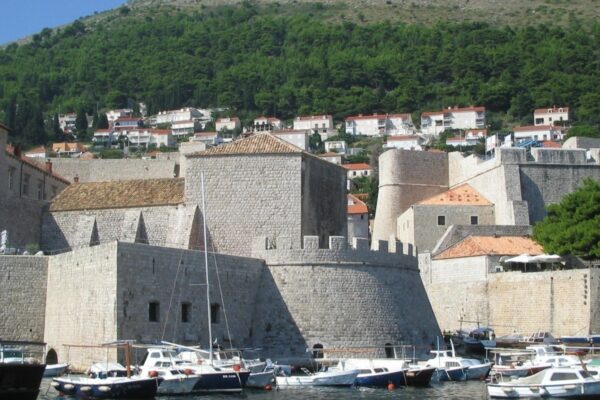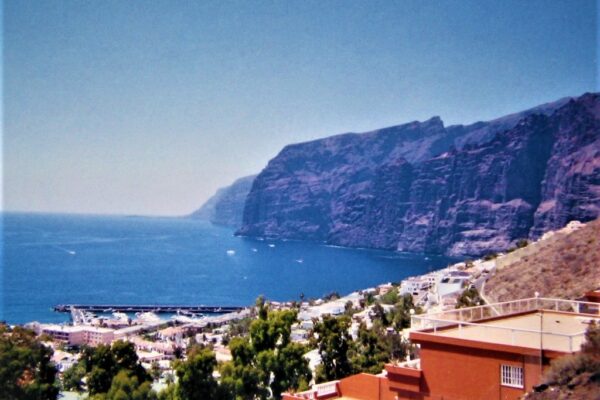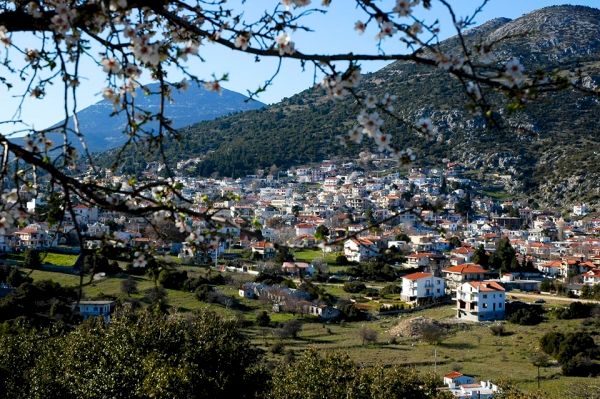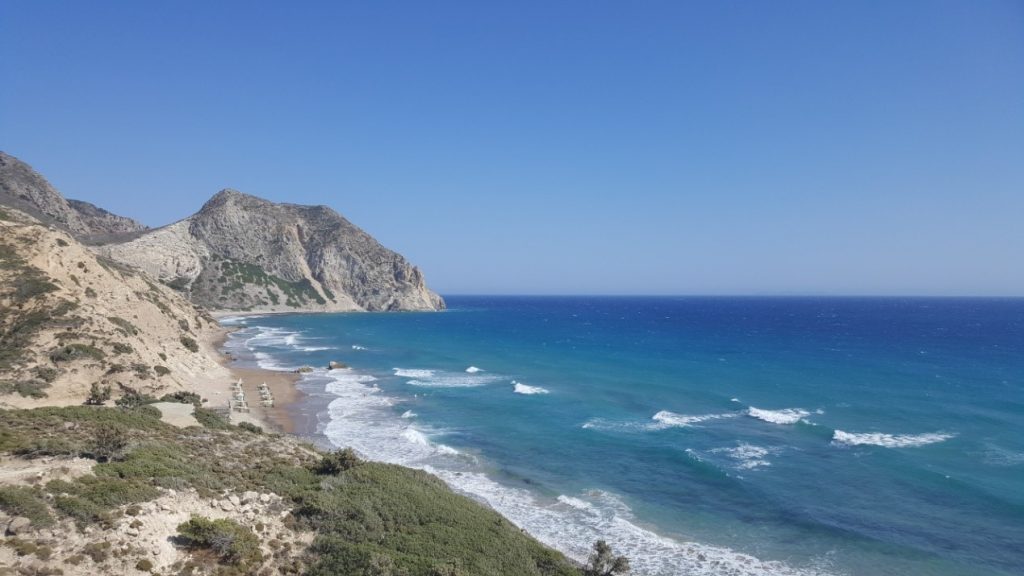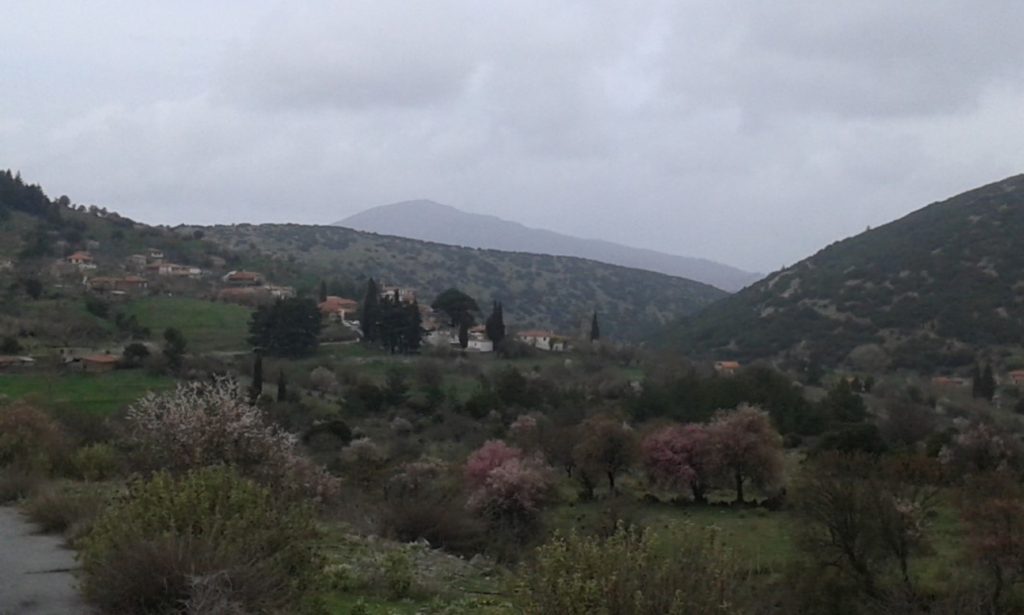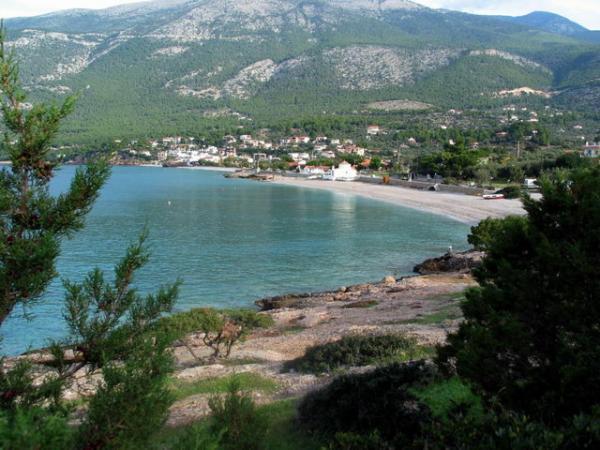Vutrint or Vutrintit or Vouthroto, the most important archaeological site in Albania
One day cruise Corfu - Sarande - Butrint
The ancient city Butrint of Albania (Albanian : Butrintit, Greek : Butrint, Latin: Bouthrotum) owned by the 1992 to World Heritage Sites of UNESCO. Peninsula Ksamili, on the banks of the lagoon Butrint (Albanian : Lake Butrint), in the Channel Vivarit (Albanian : Kanali i Vivarit), about 19 km south of Saranda (Albanian : Saranda). The Channel Vivarit It is across the strait of Corfu, in the Ionian Open sea, on the border with Greece. Its length 2,5 Km, width up 100 m. and the lake that surrounds it has an average depth 14 m. From 1948 Butrint was designated the first as cultural Monument of Albania. To 2000 founded in Butrint National Park (Albanian : park nationhtakes i Butrint) which includes the lake and the lagoon Butrint, the channel Vivari, the islands Ksamili and the Archaeological site of Butrint (2900 ha). The 2002 the wetland Butrint recognized by the Contract Ramsar. The 2005 designated as National Park (area 86 km²).
HISTORY
The Butrint is a multi-site sessions with original habitation from prehistory. According to Greek mythology was founded by Elena, son of King of Troy, Priam. Inhabited by Greeks, Romans, Byzantines, Venetians, Ottomans. There town Chaonia, an ancient Greek tribe that inhabited the ancient region of Epirus. by 4The century. B.C. the Butrint had increased significantly and around 380 B.C. The settlement was strengthened. The 229 B.C. The city passed to Romans like Corfu. The Butrint became a Roman protectorate. Developed as an important military and naval base, flourished and became the western end of Egnatia Odos. From 48-45 B.C. The July Caesar founded in Butrint a Roman colony. The 31 B.C. after the Battle of Actium, the winner Octavian Augustus extended the Roman colony placing retired legionnaires. the 1The century. A.D. the city expanded beyond the Vivarit Channel, via a stone bridge and aqueduct created. The 2The century. They built the Roman Baths, the Forum, Nimfeo and many houses. In the Middle Ages, due to its location, It was a center of trade between East and West but then abandoned as the water covered the area and the city became marsh. At the end of 5th and authorities 6th century. Butrint became the center of Bishops and the first Christian structures were developed (458 – 535 A.D.). Since the end of 6th to the 9The century. Slavs (548 A.D.) and Bulgarians (9th) They conquered the city and destroyed many buildings. By 9O century. He came under the control of Byzantium and reconstructed. From 12The century. until the 1204 found in Norman sovereignty. The 1204 After the fall of Constantinople, during the Fourth Crusade, or Byzantine Empire dissolved. then Michael A.’ Komninos Doukas founded the Domain of Epirus and became part of Butrint. The 1267 The Charles I of Anjou He took control of Butrint and Corfu. Reinforced walls and repaired the Great Basilica. The 1386 He came under the control of Venetians who expanded the fortifications and built the Venetian castle, in place of the Acropolis. The 1572 the Venetian Castle on the hill was abandoned as it was built the Castle, south of the city. The 1797 Napoleon catalyzes Republic of Venice. With the Treaty of Field Formio Venice loses most of its territories, including the Ionian and departments on the coast of Epirus, like Butrint. At his beginings 19th century. the area came under the control of Ali Pasha from Tepeleni, the Pasha of Ioannina (Albanian : Ali Pasha). The 1804 created a triangular fortress known as Ali Pasha Castle (Albanian : Castle of Ali Pasha) 2,4 km west of Butrint, the mouth of channel Vivarit, to control the strait. The remained part of Butrint Ottoman Empire until 1912 and Independence of Albania
ARCHAEOLOGICAL-WHAT TO SEE

O Archaeological site Butrint It includes finds from excavations conducted by the Italian archaeologist Luigi Maria Ugolini between 1928-1939. They brought to light important findings Prehistoric, Hellenistic, Roman and Byzantine Periods. If you visit Archaeological site you will see the following :
- ancient Acropolis (Albanian : Akropoli), 8th century. B.C. It is built on a hill, 42 m. above sea level.
- Cyclopean walls – fortification Walls. It is the oldest defensive system with additions from various periods, as those made for Emperor Justinian I.
- Ancient theater (Albanian : Theater Antique), 3th century. B.C. It is one of the best preserved ancient theaters in Albania, with 19 rows of seats and capacity 5.000 goddess of. Build it 2The half of 3th century. B.C. Hellenistic period probably over an older and smaller theater. In one of the positions is inscription 4th century. B.C. indicating that the original was built from donations faithful to the god Asclepius. The Sanctuary of God was next to the ancient theater and the site was used for religious ceremonies.
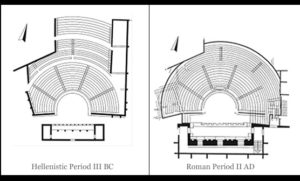
During this time the Roman period added the Stage Theater. In the area we found many statues, Greek inscriptions, graves etc..
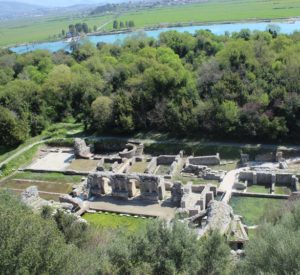
- Sanctuary of Asklepios (Albanian : The sanctuary of Asclepius), 4th century. B.C.
Found remains of the sanctuary with impressive mosaic and a marble head of the god Asclepius. In this mosaic is the image of a snake wrapped around himself, symbol of god. The Sanctuary is placed on the south side, down the hill of the Acropolis and in front of the Ancient Theater
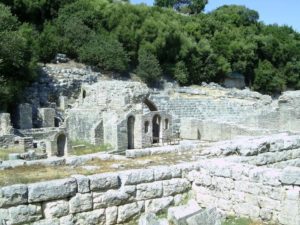
- Triconch Palace (Albanian : Palatti Trikonk ή Shtëpi / Villae), 5thcentury. A.D.
Ruins of a private Roman villa then, around 400 A.D. It was transformed into a palace of a wealthy, rather than the Senate. The rooms were built around a courtyard with a fountain and had impressive mosaics and frescoes. The most impressive mosaic was uncovered showing 5 ancient theater masks, 2 men and 2 women.

The dining room of the villa included 3 arches (triconch) and had access to the sea. Rising water levels forced the owner to abandon
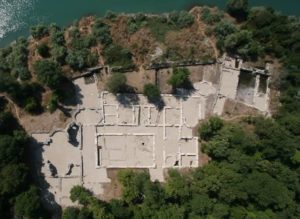
- Roman Baths (Albanian : Banja Roman/Thermae),2th century. A.D.
- Roman- Forum (Albanian : Right now/Forum)
Remains found in the south of the ancient Acropolis was used for public meetings
- High school (Albanian :Gjimnazium)
It was a large building with many rooms, beautiful mosaic floors, courtyard and fountain. Later converted into a monastery, which developed around the original courtyard
- great Basilica or Christian Basilica (Albanian : Basilica e great), authorities 6th century. A.D. Built in the early 6th century. A.D. when Butrint was Episkopi. the reconstructed 9The century. and worked again as a church until 18The century. The ruins, which are fairly well preserved, that was an impressively large building, elongate, with three aisles and outdoor arch.

- Baptistirio (Albanian : Baptisterye), authorities 6th century. A.D. discovered in 1928 by Italian archaeologist Luigi Maria Ugolini, who brought to light Baptistry, with columns and amazing Mosaic.
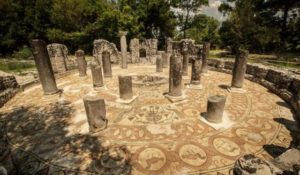
The Mosaic of the Baptistery (Albanian : Mosaic Baptistery) it is circular, diameter 13,50 m. and includes 7 rings. Each ring has different patterns, as animal performances, birds, fish, flowers, grapes, etc.. who have some symbolism.
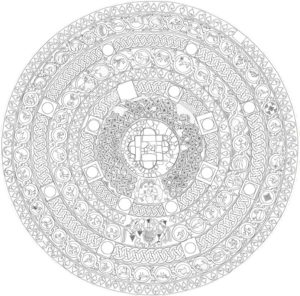
THE 1th and 5th ring show a branch with flowers of the region. THE 2th and 4th pendants are tied together to internally placed flowers, birds, fish and wildlife. The pendants are on the whole 43+26 = 69 and have different decorations. THE 3th and 6th rings are connected to each other while 7th which is larger and located around the Baptistery is the most impressive pendants. At the entrance of the Baptistery, on the threshold, The mosaic shows 2 freezing cold, symbolizing the "Immortality", sitting next to a vessel that contains "Blood" from which the "Vine" pops, that Christ. considered the 2The in Baptistery size by the Byzantine (Eastern Roman Empire) after that of St. Sophia in Istanbul.
- Nymfaio – fountain (Albanian : Nimfave/Shatervan), 2th century. A.D. Located between Baptistery and great Vassiliki. the Nymphs, in mythology, goddesses were associated with water as rivers were daughters.
- Gate Water (Albanian : Door e lake),fee 3th-Principles 4th century. B.C. It was built on the lake edge to facilitate trade.
- Lions Gate (Albanian : Door e lion) Located TO. city's. He had small opening for protection against enemies. On the upper side preserved relief illustrates a lion devouring a bull. The lion symbolizes the people and their enemies bull.
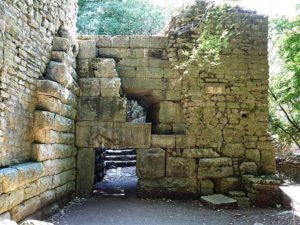
- Castle – Venetian Tower (Albanian : castle) 14th century. It was built by the Venetians on the hill of the ancient Acropolis, for protection from attacks.
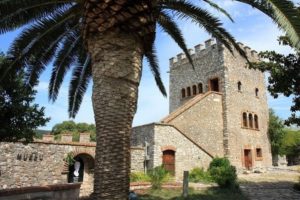
- Archaeological Museum (Albanian : Museum I city) Housed in the space of the Castle of Ancient Acropolis. You will see findings from the initial occupation and many themes, labeled in English and Albanian (open daily, 9 am-4 pm). At the site cafeteria and WC.
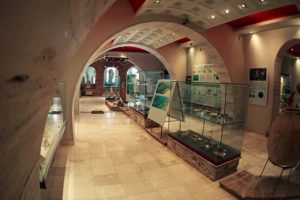
The National Park Butrint is open all year from 8 a.m. until sundown
PCCESS – Day cruise FROM TO CORFU BUTRINT
One day cruise Corfu - Sarande - Butrint -Corfu. start cruise : 27 April 2019. Departure from Port Corfu (8:50 a.m.) Arrival at the port of Saranda (Albanian : Saranda), check passports and exit (10:30 a.m.) Check in Archaeological Site Butrint guided (about 2 hours). For the elderly and for disabled people browsing the Archaeological site of Butrint is limited. Back to Saranda, coffee and tour of the city. Boarding the ship and return to Corfu (7:00 p.m.). It is possible in one-day cruise Corfu - Sarande - Butrint to include a visit to the "Blue Eye», the most popular tourist attraction in Albania.
BLUE EYE– ALBANIA
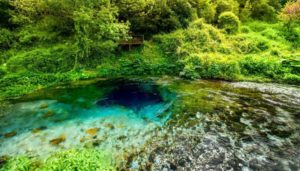
To «Blue Eye» (Albanian : Blue eye) Located 25 km from the city of Saranda, near the village Muzinë, in the area Delvina. On the surrounding area are 18 springs from the depths of the earth poured into the river Bistrica (Albanian : Bistrica), length 25 km, which flows in Ionian Sea. The main source of "Blue Eye"The source Krongj. which is located at 152 m.
The deep blue color in the center of the source arises from deep, which is not known. So far, divers have managed to reach a depth of 50 m. but not at the bottom as the current is very strong. If you throw a stone in this source will climb back to the surface after a while. This geological phenomenon is due to tectonic reasons.
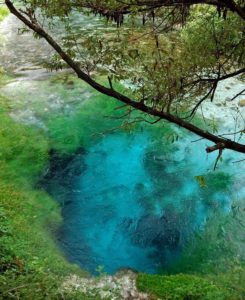
In summer many adventurous dive from high up in icy waters "Blue Eye» (water temperature 10The C). To «Blue Eye" It has been characterized natural Monument Situated in a forest of oaks, trees, walnut, cherry etc.. Entrance to "Blue Eye" They are 100 LEK = 0,80 € per person. Next to the fountain is a restaurant with regional dishes.
useful information
- Ionian Seaways, national Resistance 4, New Port Corfu, Greece, tel. : + (30) 26610 38690 – 31649 – 25155 www.Ionian-Seaways.com
- Finikas Lines, Lagjia4, Mitat Hoxha Street, Saranda,
- Harbor Saranda, Albania te.:+(35) 5852 26057, www.finikas-lines.com (Saranda Cofru Ferry Highspeed Sealine)
- Ionian Seaways, Lagjia4, Mitat Hoxha Street, Saranda, Harbor Saranda, Albania tel.: +(35) 5852 26712
International Theater Festival «BUTRINTI 2000»
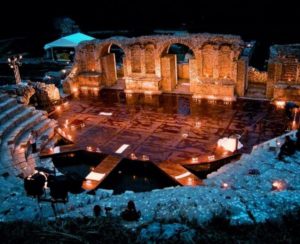
In the Ancient theater of Butrint every year International Theater Festival " BUTRINTI 2000». Founded in 2000 from National Center of Mediterranean Theater and is the most important art event of Albania. It includes cultural events with the participation of many countries artists (July).






